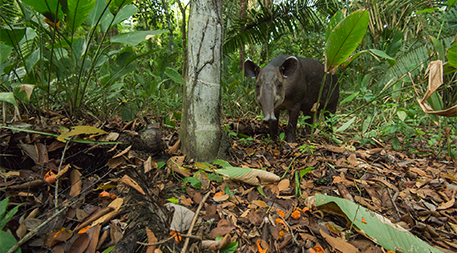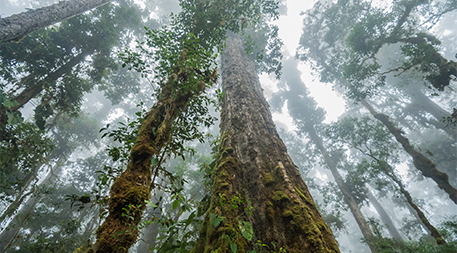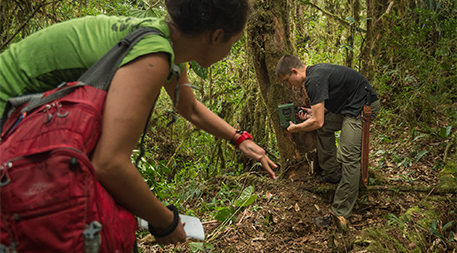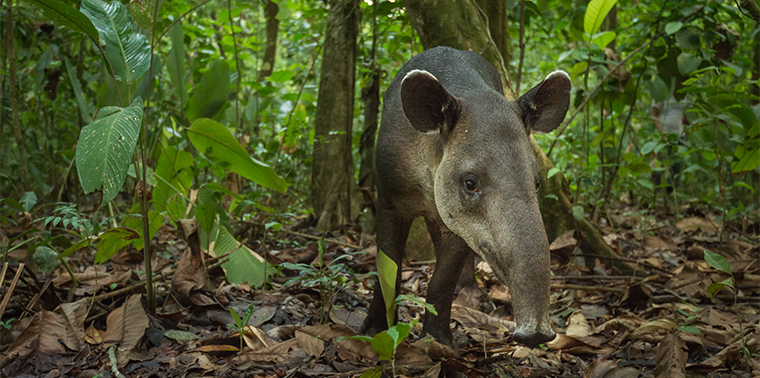September 7, 2016 — Esteban Brenes-Mora has been obsessed with tapirs — large, pig-like jungle dwellers — for as long as he can remember. It started with a sticker book his grandfather gave him as a child, and continued through zoo visits and into his university studies.
“I’ve always been passionate about tapirs,” he says. “When I studied biology I was aiming for tapirs, and since I graduated I’ve been looking for ways to study them.”
He got his chance around a year and a half ago, when he received funding from the Zoological Society of London to start Nãī Conservation (nãī is the word for tapir in the indigenous Bribri language of Costa Rica), an independent research group focused on the ecology, genetics and health of the tapirs in Costa Rica’s Cordillera de Talamanca highlands.
But it has proved to be an uphill struggle to gain support and attention for his work. Although tapirs are endangered, they just don’t figure highly in Costa Rican culture.
“If you come to Costa Rica you won’t find souvenirs of tapirs,” he says. And the local scientific community has all but abandoned them over the past 10 years. “There are not many research papers from Costa Rica related to tapirs since about 2005,” he adds.
Then, earlier this year, Brenes-Mora came across a new field of research that changed the way he thought about tapir conservation — research that links the loss of large herbivores like tapirs to the loss of a forest’s capacity to suck carbon dioxide from the atmosphere and store it in leaves, wood and roots.

New research links large herbivores to a forest’s capacity to store carbon dioxide because of the animals’ ability to disperse the larger seeds that become big trees, which store the most carbon. Photo by Nick Hawkins
The biggest trees in tropical forests, the ones that can store the most carbon, tend to have bigger seeds and rely on big, fruit-eating animals like tapirs, monkeys and large birds to disperse those seeds. “So what happens if we have forests that are empty? There will be cascade effects,” says Carolina Bello, an ecologist at São Paulo State University in Brazil, including possible changes to the amount of carbon a forest can hold.
Bello ran computer simulations of what would happen in Brazil’s Atlantic forest if the trees that depend on large fruit-eaters like tapirs, muriqui monkeys and jacutinga birds went extinct. She found that the forest’s ability to store carbon could be seriously eroded if even a small proportion of the large-seeded trees were to disappear and be replaced by smaller ones that store less carbon.
“If big frugivores disperse big trees, then carbon stocks depend on big frugivores,” she says.
Anand Osuri, an ecologist at the Tata Institute of Fundamental Research in Bangalore, India, wanted to see just how much carbon storage could be lost if large, animal-dispersed trees were removed from tropical forests around the world. Using a computer program to model the change, he found that forests could lose as much as 12 percent of their carbon storage capacity — no small amount when you consider that tropical forests account for around 40 percent of the world’s carbon stores. But it depends on where those forests are.
“In South America, Africa and South Asia the majority of forests depend on animals,” he says. “In Southeast Asia and Australia they tend to rely on wind or gravity to disperse their seeds, so those forests do just fine.”

Bigger trees in tropical forests, the ones that can store more carbon, tend to have bigger seeds and rely on big, fruit-eating animals to disperse those seeds. Photo by Nick Hawkins
In India, Osuri says, the loss of big herbivores like elephants is starting to lead to the loss of the big tree species that rely on them to disperse their seeds. “There are some parts where elephants are doing OK but others where they are in decline, especially outside the formal network of parks and protected areas,” he says. This is especially true in southern India where the surviving forests are small, fragmented and surrounded by farms.
In Costa Rica, Brenes-Mora has seized on the connection between large herbivores and carbon sequestration as a way to highlight the importance of preserving the tapirs, under threat from habitat loss as pineapple plantations expand and from traffic on the Pan-American Highway. “It has become our main card lately,” he says, when seeking support from the government or foreign non-governmental organizations.
It’s a strategy that draws the approval of Jorge Ahumada, executive director of Conservation International’s Tropical Ecology Assessment and Monitoring Network, which monitors long-term tropical biodiversity trends at field stations around the world. Ahumada says more conservation groups need to start taking this holistic view of the species and ecosystems they work with and the interactions between them.
“We focus a lot on monitoring forests at the large scale, using satellite technology, and if we see forests everybody is happy and we go home,” he says. But it’s now clear that it’s just as important to take care of the wildlife, because without the animals the forest will not fulfill the same functions that a healthy forest would.
“It’s like cutting down trees without actually cutting anything down,” Ahumada says. “There doesn’t need to be deforestation to lose carbon.”
Bello wants to see big international programs, like the United Nations’ REDD+ deforestation initiative, start to consider these links when setting conservation priorities. “It’s just beginning to be in the minds of decision makers,” she says.
That sort of thinking should make it easier to sell people on the importance of wildlife conservation, says Ahumada. “A lot of people in my business ask me, why do we care about wildlife? This is a reason why,” he says. “The argument becomes, ‘How do we conserve the part of nature that is key for people’s survival?’”
The important thing, says Ahumada, is to think beyond just saving a single species. “We might have an amazing gorilla conservation program, and that might save gorillas, but what about all the other herbivores?” he says. “It’s important to focus on conserving entire communities of wildlife, because that’s what’s going to ensure that the forest maintains its structure and function.”

Nãī Conservation team leaders Laurie Hedges and Cris Aguilar position a camera trap along a tapir trail deep within the forest. Photo by Nick Hawkins
So Nãī Conservation is trying to get the local community on board with tapir conservation by working with local schools, running workshops to enlist children as “Tapir Savers,” training forest rangers to help gather research data and talking to truck drivers to find ways to help them avoid fatal collisions with tapirs on the roads. The project is already starting to have a positive effect, he says.
“Now people in the local community are talking about tapirs, and they are really happy about having tapirs,” says Brenes-Mora.
And if they can save the tapirs, they might just save the world.
Ensia shares solutions-focused stories free of charge through our online magazine and partner media. That means audiences around the world have ready access to stories that can — and do — help them shape a better future. If you value our work, please show your support today.
Yes, I'll support Ensia!

You may also find this of interest:
Stopping the Sixth Mass Extinction
We are the first conscious species to cause an extinction event and the last that can do something about it.
http://www.ecohustler.co.uk/2015/05/18/stopping-the-sixth-mass-extinction/